?????
The same song played throug one amp has piano on the left, played through another amp has piano on the right...you call that panning?
I call it switched channels.
yes, sure....
Validations are my own concern. I have no use for circuits that don't perform as I wish, what a waste of time. People tend to insert their emotions and egos too much during discussion which makes it annoying though. I just want a logical discussion.
As far as those tube circuits I pretty much deemed them as obsolete years ago so I don't particularly care about their validation one way or the other, I got way cooler stuff now IMO. Not that I don't want to hear thoughts and opinions because I do.
I'm only bringing them out now to gauge peoples interest since I know they are a step up from typical circuits of their kind. Maybe I can generate a little coin while giving the people what they want. Probably not but it's worth a shot.
Plus it helps the conversation of whether or not tubes have a sound.
your are correct there is little coins to be made, not paper bills...
and i have to say this, i have little faith in simulations, i want to hear the real thing....
I think many are still not understanding that the two sinewaves don't measure the same, they both have distortion that can easily be measured using AP or any other suitable distortion analyser.
And no, it is not the fuzziness in the Red sinewave, that is a limitation of the scope.
Take a look at it again, please keep an open mind and I think most here will get it. Stay with me please, take it seriously, OK? That is all I ask.
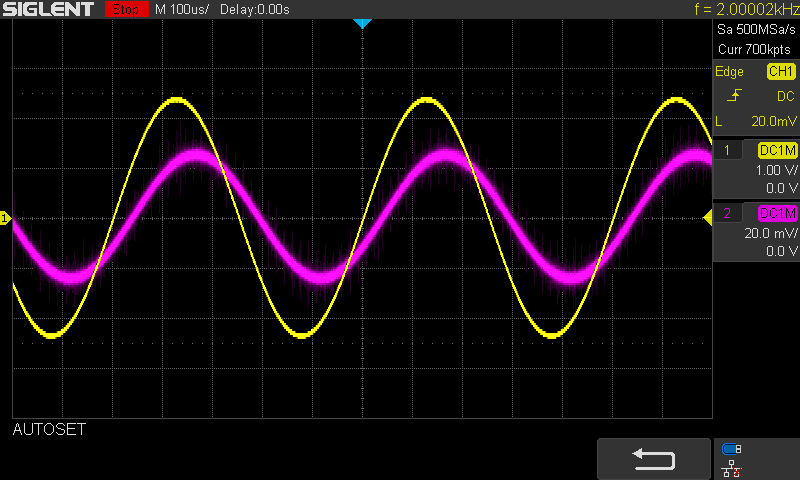
Here is how the two sinewaves are acquired.
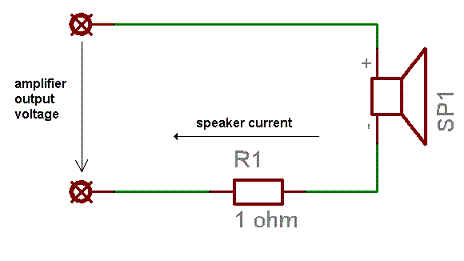
This was how Pavel did it. I did it that way too.
So the question is, why can we say this are two sinewaves?
Note that I had chosen my words were carefully chosen, I used the word simultaneously and that means a common device is being used.
Now I will quote Pavel:
"THD at amplifier output was 0.0046%, though THD distortion of speaker current was 0.111%. This is a direct influence of speaker non-linear impedance resulting in increase of current distortion. I = V/R where R is non-linear."
That is exactly what I am saying!
But I tried to point to Pavel that he had made a mistake, the speaker does not produce current, the amplifier does.
1. So the amplifier's voltage distortion is 0.0046% THD.
2. And the amplifier's voltage distortion is 0.0046% THD.
They are both sinewaves, they are both produced simultaneously.
They have to be separate sinewaves because they have different levels of distortion.
They measure differently!
The fact that we also have a 30 degrees phase shift, look above, the Red trace is to the right of the Yellow trace, points to that fact.
3. So are we listening to the low voltage distortion of the amplifier?
4. Or are we listening to the much higher current distortion of the amplifier?
Because this is what happens when we couple a non-linear speaker where the moving parts are governed by current or not voltage. Only when we have a resistor there, do we have the same result.
Please, I am asking a question about distortion, measurable distortion. What exactly are we listening to?
I feel that there must be somebody here, that some of you must understand that there are good reasons to ask questions.
I appreciate replies with substance and saying "rubbish" is not going to make the question go away.
Cheers. Joe
And no, it is not the fuzziness in the Red sinewave, that is a limitation of the scope.
Take a look at it again, please keep an open mind and I think most here will get it. Stay with me please, take it seriously, OK? That is all I ask.

Here is how the two sinewaves are acquired.
This was how Pavel did it. I did it that way too.
So the question is, why can we say this are two sinewaves?
Note that I had chosen my words were carefully chosen, I used the word simultaneously and that means a common device is being used.
Now I will quote Pavel:
"THD at amplifier output was 0.0046%, though THD distortion of speaker current was 0.111%. This is a direct influence of speaker non-linear impedance resulting in increase of current distortion. I = V/R where R is non-linear."
That is exactly what I am saying!
But I tried to point to Pavel that he had made a mistake, the speaker does not produce current, the amplifier does.
1. So the amplifier's voltage distortion is 0.0046% THD.
2. And the amplifier's voltage distortion is 0.0046% THD.
They are both sinewaves, they are both produced simultaneously.
They have to be separate sinewaves because they have different levels of distortion.
They measure differently!
The fact that we also have a 30 degrees phase shift, look above, the Red trace is to the right of the Yellow trace, points to that fact.
3. So are we listening to the low voltage distortion of the amplifier?
4. Or are we listening to the much higher current distortion of the amplifier?
Because this is what happens when we couple a non-linear speaker where the moving parts are governed by current or not voltage. Only when we have a resistor there, do we have the same result.
Please, I am asking a question about distortion, measurable distortion. What exactly are we listening to?
I feel that there must be somebody here, that some of you must understand that there are good reasons to ask questions.
I appreciate replies with substance and saying "rubbish" is not going to make the question go away.
Cheers. Joe
With that last statement in mind, it seems very silly looking back at the protracted arguments from a minority viewpoint. And that is only looking at the special case of tubes driving a speaker system of some description when there are so many other things that can present as a load to a tube stage.
-Chris
Edit: This applied to a much earlier post. I was interrupted and it was a while before I got back to it.
-Chris
Edit: This applied to a much earlier post. I was interrupted and it was a while before I got back to it.
Hi Chris
First, hoping you are doing well.
I am having the same problem. 🙂
The time zone here is different, so most of the posts happened overnight and could only barely skim them, there was a lot.
I decided then to reset the conversation with that last post.
The topic here is whether tubes have a different sound. I believe they have, and that it might even be measurable. The distortion I am pointing to has been measured by several people. To ignore that is gaslighting.
You definitely can do two simultaneous distortion measurements of the same amplifier and they are different when a speaker driver is connected. Of course, connect an ideal resistor and both will measure the same. But the driver is doing something to the amplifier and with tube amps this may still be there, but more benign (IMD may show this up better than THD) than SS amp with lots of feedback (which can correct voltage, but maybe not so well the current).
I am asking questions, I think I have good reasons to ask them.
I hope and believe others can see that.
And that the amplifier is really a current delivery system (current in motor) and tube output transformers are better at this than high feedback SS amps.
And I don't mind the idea of a Devil's Advocate, even if there are two kinds. It sharpens one's thinking.
Cheers, Joe
First, hoping you are doing well.
This applied to a much earlier post. I was interrupted and it was a while before I got back to it.
I am having the same problem. 🙂
The time zone here is different, so most of the posts happened overnight and could only barely skim them, there was a lot.
I decided then to reset the conversation with that last post.
The topic here is whether tubes have a different sound. I believe they have, and that it might even be measurable. The distortion I am pointing to has been measured by several people. To ignore that is gaslighting.
You definitely can do two simultaneous distortion measurements of the same amplifier and they are different when a speaker driver is connected. Of course, connect an ideal resistor and both will measure the same. But the driver is doing something to the amplifier and with tube amps this may still be there, but more benign (IMD may show this up better than THD) than SS amp with lots of feedback (which can correct voltage, but maybe not so well the current).
I am asking questions, I think I have good reasons to ask them.
I hope and believe others can see that.
And that the amplifier is really a current delivery system (current in motor) and tube output transformers are better at this than high feedback SS amps.
And I don't mind the idea of a Devil's Advocate, even if there are two kinds. It sharpens one's thinking.
Cheers, Joe
I'd be reading what Pavel had to say on the subject..But the driver is doing something to the amplifier and with tube amps this may still be there,
To me that sounds perfectly normal & natural for a linear motor.
There will be a phase lag between current and voltage, just look at the kind of behaviour of any motor used to drive a train or a tram.
I simply can't understand why this should be regarded as anything either bizarre or weird.
You are absolutely right!!!
But may I kindly point out that you have missed the point?
It is this, you can measure the distortion of the voltage of the amplifier and then measure the distortion (which has to come from the amplifier) and there is a BIG discrepancy, the current will have MUCH MORE distortion.
Read post #443 and let me know your thoughts.
Cheers, Joe
It is this, you can measure the distortion of the voltage of the amplifier and then measure the distortion (which has to come from the amplifier) and there is a BIG discrepancy, the current will have MUCH MORE distortion.
Actually, the distortion is coming from the speaker. No chance of changing your mind, but I had to try.
All good fortune,
Chris
I'd be reading what Pavel had to say on the subject..
Sure, I have read it numerous times. I have no doubts about his measurements, others have been done. But a different view is forming. You are in Melbourne, you know Monash University, right. I have been to the physics department and there are two there that are very interested in this, so no matter the nay-sayers here, that discussion, and also in Europe and several guys from ETF. It's never been a better time for this discussion.
Pavel says the speaker's current distortion is greater than the voltage distortion of the amplifier. Not doubting his measurement, but I think his conclusion is not entirely correct. It is the amplifier's current distortion. Yes, the speaker is the cause, but the current is that of the amplifier.
So the resonances and imperfections are mirrored in the amplifier's current. How else can the distortion go from 0.0046% to 0.111% distortion? Ask yourself, what is the cause of the increased distortion he measured?
Is anybody interested in finding out the answer to that question, where does the increase in distortion come from?
Personally, my view of the measurements is that we end up listening to the corrupted current of the amplifier being circulating between driver and amplifier. Look at Pavel's IMD distortion measurement. (Esa Merilainen of "Current Driving Loudspeakers" says the same thing, calls it feedback or feeding back.)
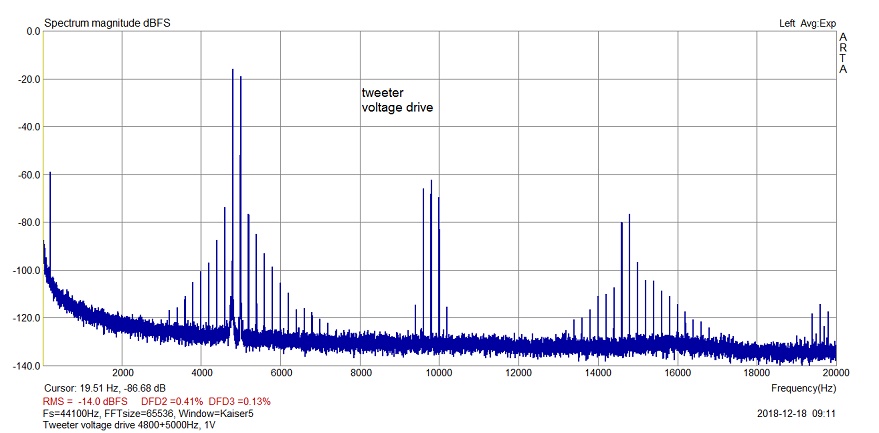
Now check how much less IMD there is with current drive:
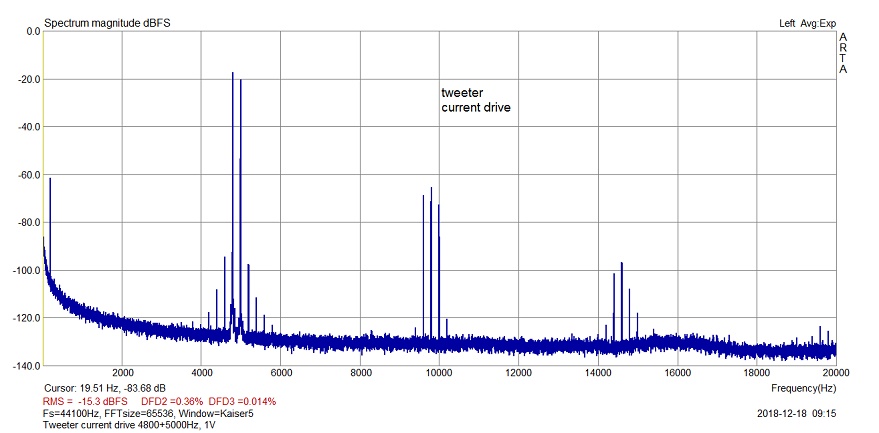
Pretty impressive, hard to ignore.
I give him full credit, note up to 20dB plus reduction in distortion and this is on the acoustic side.
This is his conclusion:
"It seems that the current drive might be an effective method to reduce odd harmonic distortion of some tweeters."
So close to being right, but...
Yes, we get lower distortion, a reduction, but his conclusion is not entirely correct. The tweeter's actual distortion is revealed when using current drive. That distortion you cannot remove. But you can add to that distortion. How?
When using voltage drive and the current distortion goes up and creates odd harmonics that is caused by an interaction between the driver and the amplifier on the current side. It is distorting the current of the amplifier and is reflected back into the tweeter. Indeed this is extensively covered in Esa's book, so I am not alone.
Pavel: Well done!
Esa: Correct conclusion.
My input: It explains the increase in odd order IMD products when getting away from current drive.
I am not unhappy if there are some here that don't accept the above view, but there are others out there thinking the same way. Often today's minority view becomes tomorrow's accepted view.
Cheers, Joe
Actually, the distortion is coming from the speaker. No chance of changing your mind, but I had to try.
All good fortune,
Chris
Please read the post that I added a minute after yours. The view is not mine entirely alone. You have to argue against others too.
PS: Nobody is arguing that the driver (tweeter) does not produce distortion, only that the amplifier is making that distortion worse and Pavel's measurements point to them being odd order.
.
Last edited:
Nobody is arguing that the driver (tweeter) does not produce distortion, only that the amplifier is making that distortion worse and Pavel's measurements point to them being odd order.
You're arguing that PMA's personal amplifier is making more distortion (0.1%) than some valve amplifiers from the mid-1950's. If this seems likely to you, stay the present course.
All good fortune,
Chris
Joe, I guess pointing out the phase shift as a way to distinguish the current waveform from the voltage one is where the presentation got lost.
Perhaps if you said here's the voltage waveform and here's its corresponding frequency spectrum.
Then said here's the current of the same system here's its corresponding spectrum... See how the current has all different harmonics and levels therein?
Then, if you hit us with here's the spectrum of the mic'd speaker's output sound pressure - see how it has the same harmonics and relative levels present as the current?
Then, now if we can reduce those by feeding the current back into an amplifiers control loop - instead of the voltage as is typical - then we can correspondingly reduce the same at the speaker SP output. See the change in the spectrum of the mic'd speaker's output sound pressure when this is done?
Here I'm assuming distortion can be equivalently expressed as a harmonic series above the fundamental (of various levels) as well as "%". Maybe easier to see it that way.
I for one would sure like to see the current harmonic profile (distortion) change with the use of current feedback, then see a corresponding change in the actual sound the speaker makes. That Siglent scope can probably make the spectrums at the touch of a button, no? Then you'd just need to mic the speaker, get that signal into the scope and do the same analysis on it.
Of course you're free to pick the very worst frequency to make your point, i.e. the one with the greatest current distortion that makes it easy to see in the spectrum. Then make the distortion go away using current feedback and show how that diminishes similarly in the actual speaker SP output.
Here's wishing you all success with being able to do so. Edit: Looks like a lot can happen while composing a reply!
Perhaps if you said here's the voltage waveform and here's its corresponding frequency spectrum.
Then said here's the current of the same system here's its corresponding spectrum... See how the current has all different harmonics and levels therein?
Then, if you hit us with here's the spectrum of the mic'd speaker's output sound pressure - see how it has the same harmonics and relative levels present as the current?
Then, now if we can reduce those by feeding the current back into an amplifiers control loop - instead of the voltage as is typical - then we can correspondingly reduce the same at the speaker SP output. See the change in the spectrum of the mic'd speaker's output sound pressure when this is done?
Here I'm assuming distortion can be equivalently expressed as a harmonic series above the fundamental (of various levels) as well as "%". Maybe easier to see it that way.
I for one would sure like to see the current harmonic profile (distortion) change with the use of current feedback, then see a corresponding change in the actual sound the speaker makes. That Siglent scope can probably make the spectrums at the touch of a button, no? Then you'd just need to mic the speaker, get that signal into the scope and do the same analysis on it.
Of course you're free to pick the very worst frequency to make your point, i.e. the one with the greatest current distortion that makes it easy to see in the spectrum. Then make the distortion go away using current feedback and show how that diminishes similarly in the actual speaker SP output.
Here's wishing you all success with being able to do so. Edit: Looks like a lot can happen while composing a reply!
Last edited:
Joe, I guess pointing out the phase shift as a way to distinguish the current waveform from the voltage one is where the presentation got lost.
Perhaps if you said here's the voltage waveform and here's its corresponding frequency spectrum...
Thank you for your considered reply, the tone is rather different from some of the others.
You make a number of points and I just want to point out that the issue here, as far as I am concerned, is all about distortion that can be measured.
No, I am not going to use that scope, a proper analyser (professional) will be used, slightly older one but it will do the job. We got an Earthworks M30 mic, very good impulse response (I have other mics here, but it is clear the M30 is in an entirely different class).
There is no doubt that the aim is to correlate distortion on the electrical side (current) with the acoustic side. Preparation for that is progressing. But it is not the only measurement. The other is how accurately the current is 'tracked' on the acoustic side and Scott Wurcer's challenge of 0.1dB accuracy. I have already done it, but rounded of to 1dB (it was still impressive while keeping it simpler) and that was posted on the blowtorch thread - and then again - and again, then finally Scott W looked at the numbers and realised what I was doing on. Then he made his 0.1dB challenge and in time I will answer it.
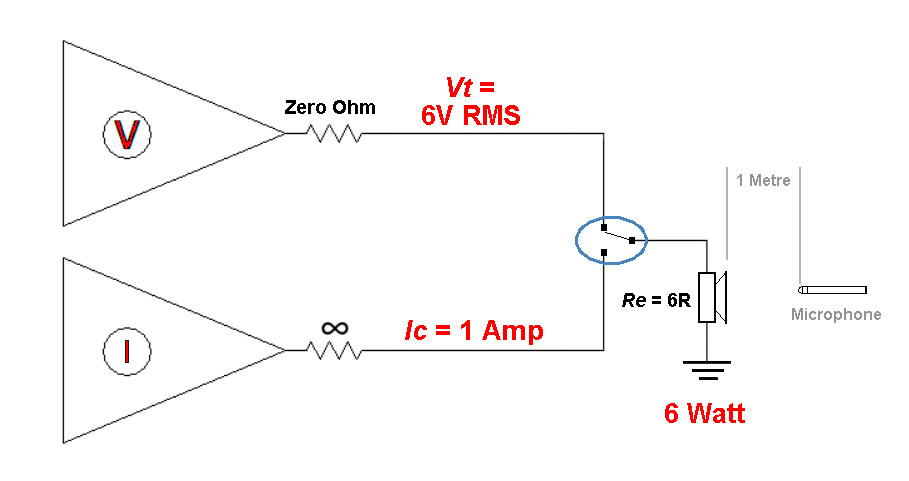
I have been talking for years with many very knowledgeable people, many of them are scientists and engineers, and received a lot of encouragement. But social media can be hell. But it can also help sharpen your viewpoint and being challenged is good, but the personality stuff can be very unpleasant.
I could repost what I did on blowtorch, but that would look like hijacking the thread? It was quite a fair bit of material and maths included.
So if you hear some say I haven't presented any evidence, they must have a hole in their heads. 😀
Just kidding.
Cheers, Joe
PS: Look at my byline below. These days you have to be brave.
Last edited:
This is his conclusion:
"It seems that the current drive might be an effective method to reduce odd harmonic distortion of some tweeters."
....It is distorting the current of the amplifier and is reflected back into the tweeter. Indeed this is extensively covered in Esa's book, so I am not alone.
My input: It explains the increase in odd order IMD products when getting away from current drive.
I am not unhappy if there are some here that don't accept the above view, but there are others out there thinking the same way.
Only problem with all this gobbledeegook is the clear admittance that in audio terms we are NOT interested in tweeter distortion, because the power levels are so low,-
and
according to Fletcher-Munson human hearing is uniquely insensitive to such frequencies, especially when they are -40dB down on the main output.
I can accept there can be some advantage in the mid range for such techniques, but then, forget doing it with some dynamic speaker, do it with ESL, - (has been done umpteen times before since 1965!) problem solved, -
they are voltage only devices, apart from when their impedance drops to almost zero from 15khz on..
In fact that was exactly the system used in Strasbourg university.
Quad ESL + large sub woofers. (with active crossover and bi amp if desired).
I can't understand why people want to solve non existent problems.
ESA even admitted to me current drive is USELESS for frequencies below 100Hz.
Can't be done, waste of time trying.
Talk about taking a sledgehammer to crack a nut!Sadly it's precisely below 70Hz that large currents and saturation conditions exist, a well as staggeringly non linear "linear motor" responses ranging from a few ohms to up to 60! 🙄
We got an Earthworks M30 mic, very good impulse response (I have other mics here, but it is clear the M30 is in an entirely different class).
It's sheer amateurism from A-Z.
Use industry standards, and you might get taken a little more seriously.
Bruel & Kjaer.
Measurements:- Hewlett Packard.
For over seven decades, Brüel & Kjær has been known for providing the highest quality products for sound and vibration measurement.
or
orAero engines
Brüel & Kjær provides tools to overcome noise and vibration challenges. These ensure the quality of new lighter material applications by modal testing and improving the quality and test efficiency in aero engines.
Aerospace
Brüel & Kjær supplies data acquisition systems and vibration test systems (LDS) to customers in the aerospace industry,
ie:-
audio
Brüel & Kjær’s sound quality solutions https://en.wikipedia.org/wiki/Wikipedia:Use_plain_English#Buzzwordsprovide the tools for recording, analysing, auditioning, dissecting, and synthesising sounds. The range enables the use of simulation models and test data to develop modifications to improve the sound quality and to achieve the ultimate objective of designing the desired sound characteristics into the product
'nuff said?

Only problem with all this gobbledeegook is the clear admittance that in audio terms we are NOT interested in tweeter distortion, because the power levels are so low,-
I am sitting here and wondering if I should add you to my no-reply list. I didn't measure tweeters, Pavel did. What gives?
He did do some THD measurements on other drivers, so before going of half-cocked, did you not follow the link I furnished - it is calling 'references' to sources.
No, the ESL is a force driven design (voltage) and if you had considered it just for ananosecond, you would have realised that. What we are discussing only applies to dynamic drivers, which are AC current linear motors. Keep ESL out of it.
I am quite familiar with Fletcher-Munson curves, even wrote some articles about them some years ago. Whether they define distortion thresholds, I am a bit dubious about such a conclusion. But if that is your view, OK then. I think that perception is not that limited, let alone hearing.
As for solving non-existent problems, maybe not. Have an open mind, OK?
ESA even admitted to me current drive is USELESS for frequencies below 100Hz.
Can't be done, waste of time trying.
What has that got to do with me?
Did I ever suggest current drive at all?
NEVER!
Unlike Esa, I am NOT in that camp. 🙄
Please, before making judgments about where I stand, at least get some facts straight before you do a Don Quixote and fight non-existent windmills.
Lighten up, I hope the sun is shining wherever you are.
Cheers, Joe
PS: No wonder I hate social media etiquette. Maybe there is no such thing in 2020, it died in the last decade.
Pavel invalidate everything he did by his own admission by using the cheapest measurement microphone he could get hold of.I am sitting here and wondering if I should add you to my no-reply list. I didn't measure tweeters, Pavel did. What gives?
It has levels of self noise and presumably distortion which would make anyone with any sense run a mile from the conclusions.
Sadly this sort of thing is pretty typical... 🙄
I look forward to that. As you are aware the current measurement at the amplifier output does not tell the whole story due to it being a reflection of the impedance nonlinearities of the speaker and largely irrelevant, it would be interesting to see to what degree it is relevant to the final acoustic output.There is no doubt that the aim is to correlate distortion on the electrical side (current) with the acoustic side. Preparation for that is progressing.
It's sheer amateurism from A-Z.
Use industry standards, and you might get taken a little more seriously.
Bruel & Kjaer.
Measurements:- Hewlett Packard.
Sigh.
My Dad actually worked for Brüel & Kjær for a while.
What does that make you? An idiot? At least get the spelling right! And yes, I am Danish! Brüel & Kjær is Danish.
You are now on my no-reply list.
Bye.
Attachments
I look forward to that. As you are aware the current measurement at the amplifier output does not tell the whole story due to it being a reflection of the impedance nonlinearities of the speaker and largely irrelevant, it would be interesting to see to what degree it is relevant to the final acoustic output.
That is also what I am after.
Just had a fun with a post who said I should use Brüel & Kjær equipment and my late Dad actually worked for a while for B&K, before going into TV as both recording engineer and electronic maintenance engineer, wearing two hats. He even recorded The Beatles for live TV. Now how is that for name dropping? My good ol' Dad.
That made my day. 😀😀😀
Cheers, Joe
Last edited:
- Status
- Not open for further replies.
- Home
- Amplifiers
- Tubes / Valves
- Do tubes actually sound like anything?
